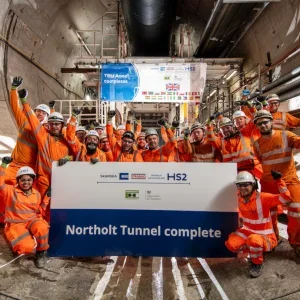On Monday 21 October, the 8.75m diameter Herrenknecht EPBM broke through on the first drive on the 2.5km long Oporto Metro, in Portugal.
Since the machine’s re-start a year ago, engineers on the project have negotiated the tricky geology with few problems. The alignment consists of continually alternating bands of fresh and weathered granite, which had previously hindered the first TBM.
Tunnelling on the line, which originally started from Campanha station in the summer 2000, was stopped after only 400m, following structural damage to buildings. In one incident in December 2000, an old lady died after her house collapsed.
According to The Portugal News in January 2001: “The foundations of the buildings have been so weakened that huge cracks have appeared in the walls, forcing the families to be evacuated… Some effort was made to strengthen the foundations of the houses when a crater appeared in one of the gardens… but clearly not enough has been done.”
This came at a time when public confidence in the project was under-mined further with the announcement that members of the administrative board were being paid almost US$10,000 per month.
However, since the restart a year ago, tunnelling has progressed smoothly with no surface damage.
The Transmetro JV is constructing the US$90.6M civil works for the client, Metro do Porto, and consists of Portugal’s Soares da Costa y Somague, and Impregilo of Italy. Jacobs Gibb Engineering provided geotechnical expertise.
The second Herrenknecht machine started boring the 2.8km drive from Salgueiro station in June this year, and will reach Trindade next summer.
The new Oporto Metro consists of a network of about 70km of lines, involving the conversion and upgrad-ing of 50km of existing surface tracks and the construction of 20km of new lines, 7km of which are underground between Campanha and Trindade, and Salgueiros and Aliados.
The underground section is composed of segmentally lined (six plus a key) bored tunnels with 7.8m i.d. and a 300mm lining thickness.







